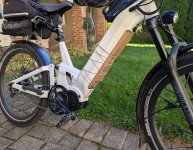Hey everyone,
After four months of daily use, I wanted to share some honest feedback on my e-bike battery replacement from EM3EV. I commute and run errands around Los Angeles — averaging over 100 miles a week — so reliability is a big deal for me.
What stood out most to me is the consistent voltage output — there’s no power sag even on steep climbs, which makes the bike feel smoother and more responsive.
I’d recommend anyone considering an upgrade or replacement to focus on quality packs that use smart BMS systems and properly balanced cells. That’s where EM3EV really seems to stand out.
If you’ve ever wondered how to safely remove your battery or install a new one, EM3EV also offers easy-to-follow tutorials — great for riders who aren’t super technical but want to handle basic maintenance themselves.
After four months of daily use, I wanted to share some honest feedback on my e-bike battery replacement from EM3EV. I commute and run errands around Los Angeles — averaging over 100 miles a week — so reliability is a big deal for me.
My Setup
- Motor: Bafang BBS02 750W
- Old Battery: 48V 14Ah (failing)
- New Battery: 48V 20Ah from EM3EV
Performance
- Range: Increased from roughly 35 miles to just over 60 miles per charge
- Charging Time: About 4.5 hours using a 4A charger
- Heat: Runs noticeably cooler even on longer rides
- Build Quality: Clean welds, solid construction, and neat wiring layout
What stood out most to me is the consistent voltage output — there’s no power sag even on steep climbs, which makes the bike feel smoother and more responsive.
I’d recommend anyone considering an upgrade or replacement to focus on quality packs that use smart BMS systems and properly balanced cells. That’s where EM3EV really seems to stand out.
If you’ve ever wondered how to safely remove your battery or install a new one, EM3EV also offers easy-to-follow tutorials — great for riders who aren’t super technical but want to handle basic maintenance themselves.


